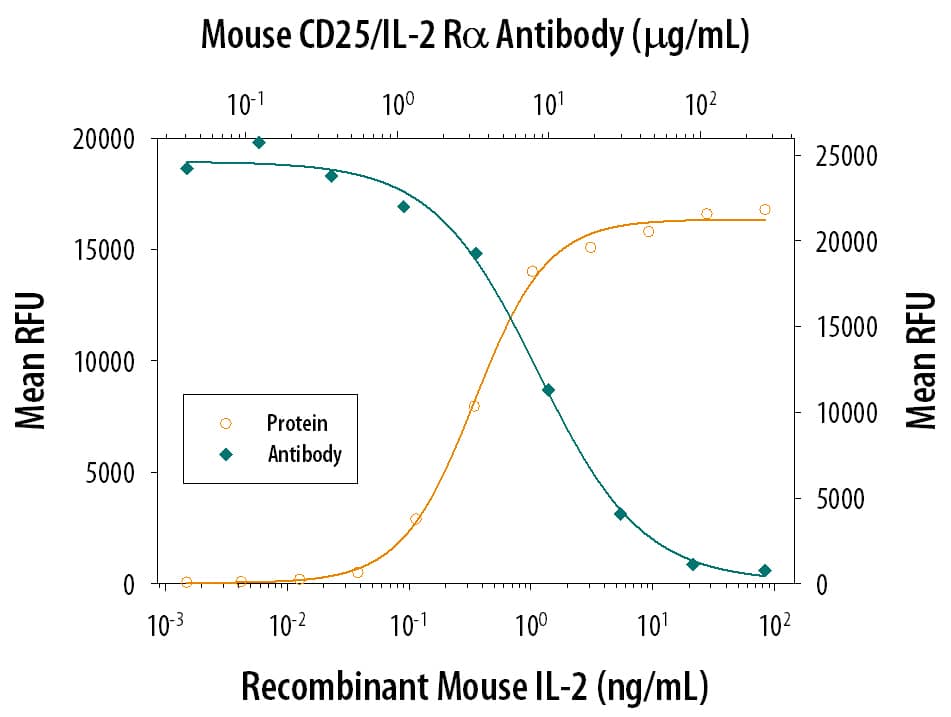Mouse IFN-gamma R2 Antibody Summary
Ser21-Val243
Accession # NP_032364
Customers also Viewed
Applications
Please Note: Optimal dilutions should be determined by each laboratory for each application. General Protocols are available in the Technical Information section on our website.
Scientific Data
 View Larger
View Larger
IFN‑ gamma Inhibition of EMCV-induced Cytopathy and Neutralization by Mouse IFN‑ gamma R2 Antibody. Recombinant Mouse IFN-gamma (Catalog # 485-MI) reduces the Encephalomyocarditis Virus (EMCV)-induced cytopathy in the L-929 mouse fibroblast cell line in a dose-dependent manner (orange line). Inhibition of EMCV activity elicited by Recombinant Mouse IFN-gamma (1 ng/mL) is neutralized (green line) by increasing concentrations of Goat Anti-Mouse IFN-gamma R2 Antigen Affinity-purified Polyclonal Antibody (Catalog # AF1185). The ND50 is typically 0.2-0.8 µg/mL.
Preparation and Storage
- 12 months from date of receipt, -20 to -70 °C as supplied.
- 1 month, 2 to 8 °C under sterile conditions after reconstitution.
- 6 months, -20 to -70 °C under sterile conditions after reconstitution.
Background: IFN-gamma R2
IFN‑ gamma R2 (Interferon gamma receptor 2; also called IFN‑ gamma R beta IFN‑ gamma RII, or AF1) is a 60‑64 kDa type I transmembrane glycoprotein that is a member of the class II cytokine receptor family of molecules (1). It is widely expressed as part of a preassembled cell surface multimeric complex. In the absence of IFN‑ gamma, the complex contains two each of IFN‑ gamma R1, R2 and Jak1 molecules (2). Binding of IFN‑ gamma to IFN‑ gamma R1 recruits Jak2 to IFN‑ gamma R2 and initiates phosphorylation, STAT1 binding, conformational changes, and transcriptional regulation, which mainly inhibits proliferation and/or promotes apoptosis (2, 3). Mouse IFN‑ gamma R2 cDNA encodes 332 amino acids (aa), including a signal sequence (aa 1‑27), an extracellular region (ECD, aa 28‑243) with two fibronectin type III domains, a transmembrane sequence (aa 244‑264) and a cytoplasmic tail (aa 265-332) (1, 2). Within the ECD, mouse IFN‑ gamma R2 shares 80% aa sequence identity with rat IFN‑ gamma R2, and 49‑55% with human, canine, porcine and bovine IFN‑ gamma R2. IFN‑ gamma R1 and R2 must be from the same species for receptor complexes to be active, and human IFN‑ gamma is not active on the mouse IFN‑ gamma receptor complex (1, 2). IFN‑ gamma R1 is essential for ligand binding and is more constitutively expressed, while IFN‑ gamma R2 is essential for signaling, and its more limited expression controls cell response to IFN‑ gamma (2, 3). For example, mouse T cell IFN‑ gamma R2 is down‑regulated during differentiation to subtypes such as Th1 which produce IFN‑ gamma. (3, 4) This allows expansion of activated cells without growth arrest due to paracrine response to IFN‑ gamma. Following expansion, IFN‑ gamma R2 is re‑expressed to limit the immune reaction (5). IFN‑ gamma signaling mediates control of intracellular pathogens such as mycobacteria (3, 4, 6). In humans, deficiency of IFN‑ gamma R2 or other IFN‑ gamma pathway molecules causes the MSMD (mendelian susceptibility to mycobacterial diseases) syndrome (6‑8).
- Hemmi, S. et al. (1994) Cell 76:803.
- Krause, C.D. et al. (2006) Cell Res. 16:55.
- Haring, J. S. et al. (2005) J. Immunol. 174:6791.
- Tau, G.Z. et al. (2000) J. Exp. Med. 192:977.
- Foulds, K.E. et al. (2008) J. Immunol. 180:842.
- Rosenzweig, S.D. et al. (2004) J. Immunol. 173:4000.
- Filipe-Santos. O. et al. (2006) Semin. Immunol. 18:347.
- Zhang, S-Y. et al. (2008) Immunol. Rev. 226:29.
Product Datasheets
FAQs
No product specific FAQs exist for this product, however you may
View all Antibody FAQsIsotype Controls
Reconstitution Buffers
Secondary Antibodies
Reviews for Mouse IFN-gamma R2 Antibody
There are currently no reviews for this product. Be the first to review Mouse IFN-gamma R2 Antibody and earn rewards!
Have you used Mouse IFN-gamma R2 Antibody?
Submit a review and receive an Amazon gift card.
$25/€18/£15/$25CAN/¥75 Yuan/¥2500 Yen for a review with an image
$10/€7/£6/$10 CAD/¥70 Yuan/¥1110 Yen for a review without an image











